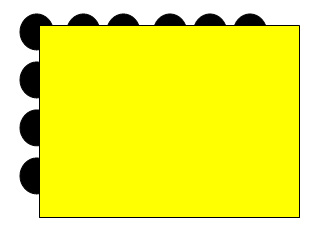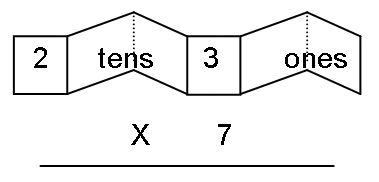Level 3: Multiplicative Thinking
Materials
-
2 Cards (pdf - 25.46kb)
- an A3 sheet of paper and 3 blank ‘name-tags’ (or business cards) measuring 9.5 cm × 5.5 cm (this needs to be accurate)
Instructions
Put Card 2 on top of Card 1 so that it is completely covered, place in front of the student, and say,
“I’m going to show you what is underneath this card very quickly and I want you to tell me what you notice?” Remove Card 2 and replace as quickly as possible. Note student’s response (eg, “there are dots in rows”).
Say, “I’m going to show you some of the dots and hide the others.” As you say this, slide Card 2 over Card 1 so that only part of the array is shown as in the diagram below. Ask,
“Can you tell me how many dots there are altogether?”
Note student’s response

If correct (24 dots), remove cards and place the A3 sheet of paper in front of the student together with the 3 blank ‘name-tags’ and say, “Can you tell me how many name-tags the same size as these could be made from this sheet of paper please?” … Note student’s strategy and response. Stop if student appears unsure about how to proceed (eg, guesses or shows no signs of manipulating cards to determine how many might fit).
3.4 Advice Rubric
This task examines the extent to which students are able to work with arrays and regions as models of multiplicative situations. In particular, it explores the strategies used by students to determine the total number of partially hidden items. This provides an important indicator of the student’s capacity to work with composite units and his/her readiness to work with more efficient mental strategies for the multiplication facts to 100.
| Observed response | Interpretation/Suggested teaching response |
|---|
Little/no response to Card task or incorrect (eg, may observe rows and columns or “grid”, but counts only what can be seen) |
May not understand task and/or ‘trust the count’ for 4 or 6, may not be able to keep track of the count - Use subitisation cards to check part-part-whole understanding for numbers to 5 and the extent to which students can recognise and work with numerals to 5 without having to model or count by ones (trusting the count)
- Build number fact knowledge (and trusting the count) to 10 using subitisation cards and ten-frames (ie, recognise 7 is 5 and 2 more, 3 and 4, 1 more than 6, and so on).
- Use two large dot dice and/or ten-frame cards to model counting on (ie, cover number that is known and count on by ones), extend to counting on by 1, 2 or 3 mentally
- Use 2-row bead frames and ten frames to build doubles knowledge to 20
|
Counts by ones to get 24, may point to keep track of the hidden dots and/or use partial skip count (eg, counts by 3s to 18 then counts on top row by ones), experiences difficulty with A3 task (eg, may not realise cards need to be placed in same orientation) |
May not be able to work with 4 or 6 as a countable unit, may not ‘trust the count’ or be able to keep track of a skip count - Use subitisation cards to check part-part-whole understanding for numbers to 10 and the extent to which students ‘trust the count’ for numbers 5 to 10
- Use ten-frames and 2-row bead frames to build knowledge of doubles, rehearse the use of doubling to more efficiently determine the number in an array (eg, for 5 rows of 6, think: double 6 is 12, double that again is 24 and 1 more 6 is 30)
|
More substantive attempt to skip count for initial task (eg, doubles 6 then doubles again to get 24) and some indication that ‘name-tags’ are being used to estimate number of rows and/or columns |
Able to work with 4 and/or 6 as composite unit, some access to skip counting or more efficient counting strategies, recognises the value of array/region representations but may not be able to make use of these without modelling - Consider introducing/consolidating array-based strategies for multiplication facts, eg, for 2s facts (2 ones, 2 twos, 2 threes, …) think doubles, for 3s facts (3 ones, 3 twos, 3 threes, …) think double the group and one more group etc (See
Developing the Big Ideas in Number (pdf - 125.23kb))
- Extend to region models and develop multiplication strategies to 100 and beyond (eg, 9 twenty-threes, think: less than 10 twenty-threes (230), one group less, 207)
|
Uses known fact to determine 24 dots, systematically arranges ‘name-tags’ to determine 20 (if longer edge of cards aligned with longer edge of A3) or 21 (if shorter edge of cards aligned with longer edge of A3) |
Indicates knowledge of relevant number facts and an understanding of the applicability of the region model of multiplication - Consolidate mental strategies for multiplication to 100 and beyond (eg, 9 twenty-threes, think: less than 10 twenty-threes (230), one group less, 207)
- Introduce symbolic recording for basic facts and discuss informal strategies for multiplying larger numbers by single digit numbers
- Consider introducing the
area idea for multiplication by using MAB (Base 10 blocks) to explore 1 digit by 2 digit multiplication (eg, represent 7 by 23 as 7 rows of 2 tens and 3 ones), discuss convenience of this as opposed to 7 rows of 23 ones
- Use Number Expanders to support recording and working with place-value parts (eg, 7 by 3 ones … 7 by 2 tens)
 |